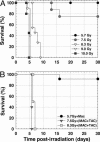Selective irradiation of the vascular endothelium has no effect on the survival of murine intestinal crypt stem cells
- PMID: 16505359
- PMCID: PMC1383492
- DOI: 10.1073/pnas.0600133103
Selective irradiation of the vascular endothelium has no effect on the survival of murine intestinal crypt stem cells
Abstract
The possible role of vascular endothelial cell damage in the loss of intestinal crypt stem cells and the subsequent development of the gastrointestinal (GI) syndrome is addressed. Mice received whole-body epithermal neutron irradiation at a dose rate of 0.57 +/- 0.04 Gy x min(-1). An additional dose was selectively targeted to endothelial cells from the short-ranged (5-9 microm) particles released from neutron capture reactions in 10B confined to the blood by incorporation into liposomes 70-90 nm in diameter. Different liposome formulations produced 45 +/- 7 or 118 +/- 12 microg/g 10B in the blood at the time of neutron irradiation, which resulted in total absorbed dose rates in the endothelial cells of 1.08 +/- 0.09 or 1.90 +/- 0.16 Gy x min(-1), respectively. At 3.5 d after irradiation, the intestinal crypt microcolony assay showed that the 2- to 3-fold increased doses to the microvasculature, relative to the nonspecific whole-body neutron beam doses, caused no additional crypt stem cell loss beyond that produced by the neutron beam alone. The threshold dose for death from the GI syndrome after neutron-beam-only irradiation was 9.0 +/- 0.6 Gy. There were no deaths from the GI syndrome, despite calculated absorbed doses to endothelial cells as high as 27.7 Gy, in the groups that received neutron beam doses of <9.0 Gy with boronated liposomes in the blood. These data indicate that endothelial cell damage is not causative in the loss of intestinal crypt stem cells and the eventual development of the GI syndrome.
Conflict of interest statement
Conflict of interest statement: No conflicts declared.
Figures




References
-
- Potten C. S., Booth C., Tudor G. L., Booth D., Brady G., Hurley P., Ashton G., Clarke R., Sakakibara S., Okano H. Differentiation (Berlin) 2003;71:28–41. - PubMed
-
- Potten C. S. Radiat. Res. 2004;161:123–136. - PubMed
-
- Withers H. R., Elkind M. M. Int. J. Radiat. Biol. Relat. Stud. Phys. Chem. Med. 1970;17:261–267. - PubMed
-
- Hornsey S. Radiat. Res. 1973;55:58–68. - PubMed
-
- Paris F., Fuks Z., Kang A., Capodieci P., Juan G., Ehleiter D., Haimovitz-Friedman A., Cordon-Cardo C., Kolesnick R. Science. 2001;293:293–297. - PubMed
Publication types
MeSH terms
Substances
Grants and funding
LinkOut - more resources
Full Text Sources
Miscellaneous

